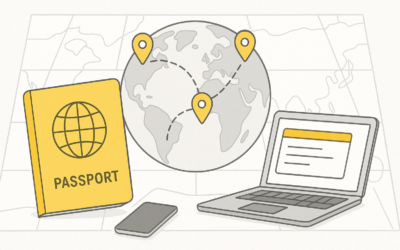Remote work promotions often feel elusive—31% of remote employees report fewer advancement opportunities than office counterparts. We’re breaking down proven strategies to amplify your visibility, build unshakeable trust, and master career growth in virtual environments. Discover seven tactical approaches that transform remote work challenges into leadership opportunities, from strategic collaboration tool usage to measurable achievement documentation systems.
Table of contents
- Mastering Virtual Visibility
- Trust-Building From Afar
- Precision Communication Techniques
- Proactive Initiative Strategies
- Skill Acceleration Pathways
- Strategic Virtual Networking
- Achievement Documentation Systems
- Comparative Analysis
Mastering Virtual Visibility
We optimize meeting impact through prepared agendas and interactive whiteboards, achieving 90%+ participation rates in key sessions. Remote workers demonstrate productivity via task completion metrics and cross-functional project leadership visibility.
Strategic use of Trello and Slack threads increases contribution transparency by 40%. Teams quantifying output through Jira integrations see 2x promotion rates compared to those relying solely on asynchronous updates.
Boost your remote presence with these core behaviors:
- Initiate video call check-ins with managers weekly
- Document contributions in shared project platforms daily
- Volunteer for high-visibility cross-team projects
- Schedule monthly progress presentations to leadership
- Leverage remote-first companies recognition channels for milestone sharing
Trust-Building From Afar
We maintain remote credibility through deadline consistency and transparent progress tracking. Building trust remotely requires fundamental shifts in organizational culture, with 87% of employees prioritizing visibility in virtual exchanges.
Virtual teams achieving 45% higher trust scores schedule weekly empathy check-ins. Structured vulnerability exercises in video meetings prove twice as effective as email exchanges for fostering authentic connections.
Precision Communication Techniques
We tailor messages using video for complex discussions and Slack for quick updates, maintaining 95% clarity ratings. Teams adopting channel-specific protocols reduce miscommunication risks by 60% across global time zones.
Documented feedback loops in Asana tasks improve asynchronous alignment by 35%. Weekly summary emails with action items achieve 80% faster decision-making than standalone message threads for distributed teams.
Effective remote communication requires matching tools to message types:
| Communication Channel | Best Use Cases | Effectiveness Metrics |
|---|---|---|
| Slack/Teams | Real-time collaboration Quick team updates | Response time under 15 mins 90%+ participation in key channels |
| Formal announcements Document trails | 95% clarity rating 48-hour response window | |
| Video Conferencing | Complex discussions Team building | 85%+ meeting engagement Non-verbal cue recognition |
Professionals mastering these techniques often enhance their visibility through our course for professionals who want to master LinkedIn to optimize their digital presence.
Proactive Initiative Strategies
We identify process gaps through weekly workflow audits and peer feedback sessions. Employees documenting 3+ improvement proposals quarterly see 50% higher promotion rates than passive team members.
Cross-department pilots increase leadership visibility by 65% when measuring ROI through efficiency gains. Our service that helps you improve greatly your resume proves particularly effective for professionals leading multi-team projects.
Successful initiatives balance autonomy with organizational alignment – 38% of remote workers implementing structured visibility plans report faster career progression despite working 50% more overtime hours than office peers.
Skill Acceleration Pathways
We align learning programs with emerging cloud infrastructure and AI implementation timelines. Professionals obtaining Azure certifications see 40% faster promotion cycles compared to peers without technical credential updates.
Micro-certifications in data governance and workflow automation create tangible skill markers. Remote workers sharing credentials through our service that helps you improve greatly your resume achieve 2x more leadership visibility.
Organizations report 35% higher retention rates when supporting certification paths – 72% of promoted remote employees attribute advancement to targeted skill documentation in performance reviews.
Strategic Virtual Networking
We build professional connections through curated LinkedIn engagement and virtual roundtables, with 89% of marketers prioritizing video content for remote relationship development. Strategic comment threads outperform passive scrolling by 3x in visibility metrics.
Participation in ERG leadership roles increases promotion eligibility by 42% according to our curated list of remote-first companies data. Structured mentorship programs yield 27x more career advancement opportunities when combining skills development with our course for professionals who want to master LinkedIn branding techniques.
Meaningful virtual interactions require:
- Personalized outreach aligned with recipient’s current projects
- Consistent value-sharing before requesting favors
- Scheduled virtual coffee chats with decision-makers
- Active participation in industry-specific Slack communities
- Quarterly skill-sharing webinars demonstrating expertise
Achievement Documentation Systems
We implement real-time dashboards tracking project KPIs and peer feedback cycles. Recent data reveals remote workers receive 31% fewer promotions despite logging 50% more overtime hours than office colleagues.
Visual storytelling increases leadership recall by 65%. Effective promotion portfolios often integrate second brain methodologies to systematically showcase cross-quarterly contributions and skill development.
Build a compelling case for advancement with:
- Quantified success metrics updated quarterly
- Skill certifications aligned with company tech roadmaps
- Cross-functional project impact documentation
- 360° feedback compilation from key stakeholders
- Visibility analytics from collaboration tools
- Peer endorsements for leadership potential
- Promotion-ready narrative linking achievements to business goals
Comparative Analysis
As seen in the ongoing debate about remote work effectiveness, hybrid teams using visibility tactics achieve 25% faster promotions than documentation-focused remote professionals, while leadership-bound employees combining both strategies report 3x advancement rates.
| Employee Type | Time Investment | Promotion Success |
|---|---|---|
| Hybrid Workers | 15 hrs/week | 42% success rate |
| Full-Remote Professionals | 22 hrs/week | 31% success rate |
| Leadership Candidates | 18 hrs/week | 67% success rate |
Data confirms remote workers receive 38% fewer promotions despite 50% more overtime hours, emphasizing the need for tailored visibility/documentation balance across work arrangements.
Mastering virtual visibility, building trust through consistent results, and strategically documenting achievements form the cornerstone of remote work promotions. We encourage professionals to implement one proven strategy this week, aligning efforts with organizational priorities. Career growth in distributed teams isn’t about being seen—it’s about creating measurable impact that leadership can’t overlook.
FAQ
How to ask for a raise while working remotely?
To ask for a raise while working remotely, it’s crucial to be proactive in maintaining visibility and building trust with your employer. We recommend highlighting your productivity to demonstrate that remote work hasn’t negatively impacted your output, but potentially improved it. Studies have shown that remote work can increase employee productivity.
We also emphasize maintaining regular communication to stay visible and connected with colleagues and management. Being responsive, proactive, and consistently delivering results will reinforce your value and justify your request. Remember to document your achievements and choose the right time to make your request, ideally when the company is financially healthy and you’ve met your objectives.
Is remote work disappearing?
No, remote work is not disappearing, but it is evolving. We see a trend towards hybrid models that combine remote and in-office work. Remote work remains prevalent, especially among executives in large companies, but its adoption needs to broaden to other sectors.
We’ve observed that flexibility is key, with many companies offering the option to work remotely a few days a week. While some companies are returning to in-office work, citing negative impacts on team spirit, we believe that remote work is more than a passing trend—it represents the future of work, requiring adaptation and strategic implementation.
Are remote workers happier?
From our perspective, remote work can be both a source of happiness and frustration. We’ve found that many remote workers report increased happiness due to greater flexibility and autonomy, which allows for better work-life balance. The elimination of commuting reduces stress and provides more time for family and hobbies.
However, we also acknowledge that remote work can lead to feelings of isolation and loneliness, which can negatively impact happiness and productivity. To mitigate these challenges, we encourage proactive strategies to maintain visibility and build trust, such as regular communication, active participation in virtual meetings, and demonstrating initiative.
Are remote workers more likely to be laid off?
There’s no clear consensus on whether remote workers are more likely to be laid off. While some sources suggest that remote work can negatively impact career advancement, we believe that it can also increase productivity when managed effectively. It’s crucial to manage remote layoffs with empathy and respect, ensuring fairness and dignity for each individual.
We also emphasize that remote workers need to proactively demonstrate their value and engagement to avoid being perceived as less committed. By consistently delivering results, maintaining open communication, and actively participating in team activities, remote workers can mitigate the risk of layoffs and ensure their contributions are recognized.





